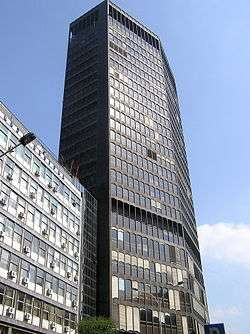Architecture of Belgrade


Architecture of Belgrade refers to the architecture and styles developed in Belgrade, Serbia. Belgrade has wildly varying architecture, from the centre of Zemun, typical of a Central European town,[1] to the more modern architecture and spacious layout of New Belgrade. The oldest architecture is found in Kalemegdan park. Outside of Kalemegdan, the oldest buildings date only from 19th century, due to its geographic position and frequent wars and destructions.[2] The oldest public structure in Belgrade is a nondescript Turkish türbe, while the oldest house is a modest clay house on Dorćol, from late 18th century.[3] Western influence began in the 19th century, when the city completely transformed from an oriental town to the contemporary architecture of the time, with influences from neoclassicism, romanticism and academic art. Serbian architects took over the development from the foreign builders in the late 19th century, producing the National Theatre, Old Palace, Cathedral Church and later, in the early 20th century, the National Assembly and National Museum, influenced by art nouveau.[2] Elements of Neo-Byzantine architecture are present in buildings such as Vuk's Foundation, old Post Office in Kosovska street, and sacral architecture, such as St. Mark's Church (based on the Gračanica monastery), and the Temple of Saint Sava.[2]
During the period of Communist rule, much housing was built quickly and cheaply to house the huge influx of people from the countryside following World War II, sometimes resulting in the brutalist architecture of the blokovi (blocks) of New Belgrade; a socrealism trend briefly ruled, resulting in buildings like the Trade Union Hall.[2] However, in the mid-1950s, the modernist trends took over, and still dominate the Belgrade architecture.[2]
See also
- List of notable buildings in Belgrade
- List of notable streets and squares in Belgrade
- Architectural projects under construction in Belgrade
- Religious architecture in Belgrade
- Gates of Belgrade
- Architecture of Serbia
References
- ↑ Nicholas Comrie, Lucy Moore (2007-10-01). "Zemun: The Town Within the City". B92 Travel. Retrieved 2007-05-17.
- 1 2 3 4 5 Zoran Manević. "Architecture and Building". MIT website. Retrieved 2007-05-19.
- ↑ Prof. Dr. Mihajlo Mitrović (2003-06-27). "Seventh Belgrade triennial of world architecture". ULUS. Retrieved 2007-05-19.

